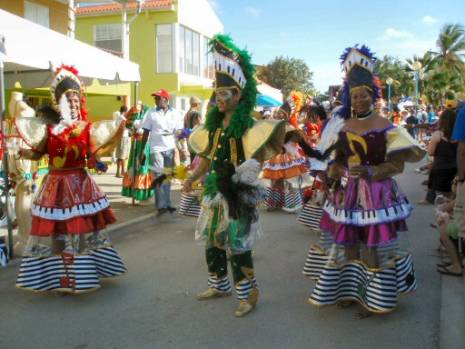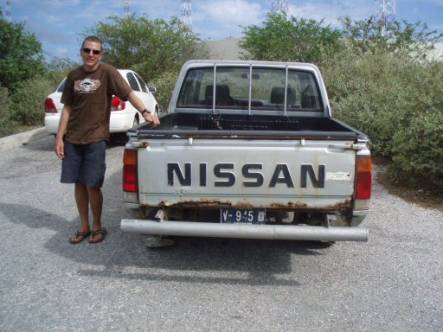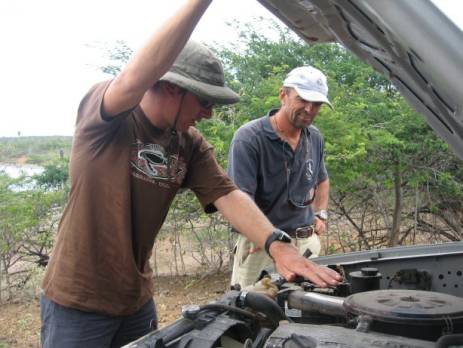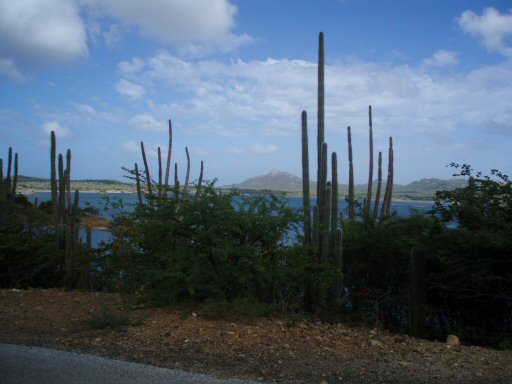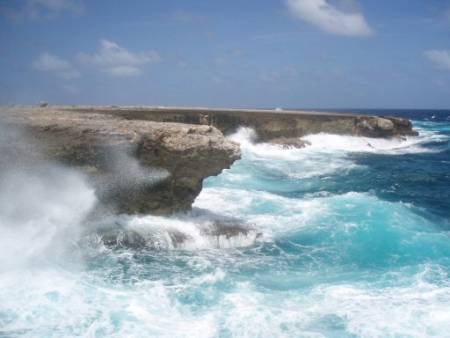Bubbles and Bumpy Roads in Bonaire

30 January – 12 February 2008 : Bonaire
We arrived in Bonaire as dawn broke the morning after leaving Los Roques. As we rounded the south-eastern corner of the island the swell died down and we had a great sail up the western coast, cruising at 8-9 knots with full main and Genoa. As we sailed past the salt flats we were greeted by a flock of flying pink flamingos, and huge schools of flying fish scattered in our wake. Bonaire is part of the Netherlands Antilles and the waters around the island are a marine nature reserve, making it one of the world’s top diving destinations. The underwater life is amazing and there are whole books detailing all the dive sites around the shores all of which are marked by a buoy or a sign on the shore. This eliminates the need to employ a guide, and as I had my very own Dive Master onboard I was looking forward to exploring the marine life on our own.
As anchoring is prohibited everywhere in Bonaire to protect the reefs, we picked up a mooring buoy directly opposite a dive centre and near the centre of the capital, Kralendijk. Once all the clearing in formalities were completed we discovered that our sail had still not arrived so we got on with some serious shopping. We ordered some things from the chandlers that we did not manage to buy in Grenada, and then set upon the task of finding me some cheap second hand diving gear. I figured that as we were planning to dive here at least once a day, and would probably do a lot of diving in the Pacific, it was time I owned my own equipment. Bonaire is littered with dive shacks, so competition was high and prices low. It was a good place to buy diving stuff, though unfortunately a BCD in my size proved difficult to come by. Eventually we found what we were looking for, and I was the owner of some shiny (well, faded and used really) diving equipment.
I will have to let James tell you about the diving in Bonaire in his next Bubble Blog (I will get around to it eventually!…J). We went snorkelling around the boat on our first day in Bonaire, and I was amazed by the huge number and range of marine life. We were moored right on top of a reef and a very popular dive site, and as soon as we got in the water we could see what everyone was ooh-ing about. There were huge schools of colourful fish everywhere, in many different colours. The small fish had attracted some larger predators, and the water was so clear we could see them all lurking in the shadows 20m down. The following day we rented some air cylinders from the dive centre nearby and went for a dive under Rahula. The reef was even more beautiful close up. The only thing that marred the experience was my left ear, which would not clear and started to feel uncomfortable at depth. We did another dive together near the marina breakwater a few days later. This time my ear started to get painful at 5m, so we surfaced immediately. There was nothing for it, I had to go to the doctor and find out what was wrong.
I booked an appointment at a local clinic, and arrived 5 minutes before the allotted slot. Then I was told they were “running a little late” and the doctor probably wouldn’t see me for at least a couple of hours. James had gone back to the boat in the dinghy, so I was stranded in town. I wandered around the shops for a while, then returned to the clinic hoping they had caught up with their appointments. I had flicked through all the Dutch magazines, watched all the other people, and wrote a blog by the time I was finally seen, 4 hours after my original appointment time. In the first 5 minutes the doctor told me what I already knew – I had burst my eardrum. No more diving and snorkelling for me until it heals. I was very upset I wasn’t going to get to use my new diving kit, or see any more of the pretty Caribbean fish!
There were quite a few other yachts in Bonaire, and many of the crews had been there a while sampling all the dive sites. It was a really friendly anchorage, and we quickly made some new friends. On Thursdays the Marina bar has a Happy Hour for cruisers, and we went along and chatted to other sailors. Many had been in the area for a while and had plenty of advice for our onwards journey to Curacao and Cartagena. Some were spending the season in the Caribbean, and some were like us, keen to press on and make the season in the Pacific. It was useful to exchange ideas and experiences with like-minded people. As with all small groups of people there was gossip to be shared, and we soon found out that on one of the boats the skipper had died suddenly on Monday night. He was only 30 and was on an extended honeymoon with his young wife. They had two crew onboard and were bound for Panama, where the crew were due to meet another boat to sail across the Pacific. The crew, Helen and Charlie, had moved onto another boat to give the widow some space and were looking for a ride to get them to Panama by the end of the month. As soon as people found out we were heading that way soon, we were introduced, and we agreed to go out with them one night to see if we wanted to have them onboard and vice versa.
We had a great night out with Helen and Charlie and discovered we had lots in common. They are only a year or so younger than us, and worked for a while before deciding to give it all up and go travelling. They had been crewing on yachts since November and wanted to get as far as New Zealand. They had considered buying their own yacht to sail around the world but didn’t think they had enough experience. As it turned out, they had managed to encounter various disasters on the four boats they had crewed for so far that many people never come across in 20 years of sailing. We agreed to take them to Panama, pleased to have the company and for the chance to try out sailing with crew before committing to having strangers as crew in the Pacific.
On another night we were invited onboard the boat next door for sundowners. The boat was owned by a Scottish couple, Alan and Fiona, who had moved to Canada. Alan had built boats for a living, and the boat they were cruising on was one of his company’s models. It was a lovely boat, and we were fascinated to hear Alan’s tales of the boat building industry (for those that remember, he built the ‘Spring’ yachts that were featured in that 80s yachting soap ‘Howard’s Way’ and he had some funny stories about sailing the boats from the saloon while the actors were being filmed in the cockpit. Or something like that anyway, I was a little tired…J) (More like very drunk! A). We were joined by a couple of guys from another boat, and the gin flowed pretty freely. Before we knew it the sun had set, James was reaching sleepy drunk mode, and it was time to hop back to Rahula in the dinghy before things got too embarrassing…
Other than the yachtie social scene, Kralendijk is a small and sleepy town with not much to do. The population of the town trebles when a cruise liner comes in, but usually life continues at a slow relaxed Caribbean pace. This all changed in our first weekend on the island, which was Carnival time. The town came alive to the sounds of samba, whistles and loud reggae music. The parade was due to pass through the town centre on Sunday afternoon and we met up with Eva and Wolfgang early to get a good spot on the teeming streets. In the end the streets weren’t that crowded, and we had a restless two hour wait for the parade to pass our chosen spot (the wait was of course speeded up by a few cold beers…). The Carnival parade was really good fun, even though we didn’t understand what some of the floats were about, and the costumes were more homemade (a charitable description…J) than at some of the famous South American carnivals. Some of the floats had sound systems that were so loud you couldn’t hear the music, but your body danced involuntarily as each atom jigged to the bass rhythm. James was disappointed because there weren’t enough pretty skinny girls strutting with only a few sequins to cover their modesty, but beamed once he gulped his n-th beer and the Carnival queen came past... The parade passed through the town again a few nights later, and someone recommended we went to see all the lights. We went along with Charlie and Helen who missed the parade first time around, and found that the procession was exactly the same as the daylight parade, but this time the participants adorned their costumes with some UV jewellery!
|
|
|
| |
|
| |||
|
|
| ||
|
Bonaire Carnival | |||
As diving was now out of the question because of my ruptured ear we decided to rent a car for a day to see what the solid part of the island had to offer. We asked for a large car as we were going to travel with Eva and Wolfgang but the hire company only had small Suzuki jeeps on the day we wanted. We arrived at the office as it opened in the morning and asked again if a larger car was available. The lady in the office said she did have a pick-up truck, but they do not usually rent it out. We preferred to have the space, so we said we would take it if possible. A phone call to the manager later she handed over the keys and took us outside to meet our transport for the day. I immediately saw why the car was usually off limits; this thing was a complete wreck. It was about 30 years old, rusty and full of dents. The office lady had the cheek to still come out with a clipboard to mark the location of all the dents and scratches before we took on the car. We gave up with trying to find all the dents, as there were too many, so James just got her to note that one of the stickers was missing on the side!
When we got into the car Eva suggested we should name it as it had so much character. James suggested “it”, and the name stuck. Driving the car became a test of willpower. The car always wanted to go one way, and James kept trying to force it to go the way we wanted (or at least to stay on the road!). He was turning the wheel so much he looked like a young kid does when pretending to drive. The brakes only worked on one side, so if James braked too hard the car started to spin round. I tried to roll down the window and the handle just came off in my hand. We didn’t have much faith in the temperature gauge (because the aircon was just blasting hot air), so every so often James would lift the bonnet and check the engine was still there. There was no handbrake, and after a few run away moments James found a suitable rock to use instead. We left the “handbrake” in the car when we returned it, and told the lady in the office that we had fixed the handbrake. She was a little surprised, until she saw the rock and laughed.
|
|
|
|
James and
“It” | |
|
| |
|
Checking the
Engine | |
We took a circular route around the island, heading north first past the huge aerial farm belonging to Radio Netherlands and plenty of shore dive sites. The landscape was barren scrubland with huge cacti rising high above dry, thorny bushes. It looked almost green but was a desert compared with the lush flora of the eastern Caribbean. We passed a salt water lake and caught our first glimpses of flamingos bathing in the shallow water, their bright pink feathers presenting a stark contrast to the dull brown landscape.
|
|
|
|
Bonaire
Landscape |
Flamingo |
The northern section of the island has been cordoned off and conserved as a national park which was recommended as a sightseeing adventure. We paid the entrance fee, and trundled off into the bush heading for the recommended sites of interest marked on the map. Within 100m the road deteriorated into an undulating, rocky path over which the car bounced and shuddered. This was not a good point to discover that the suspension was shot as well, as we felt every bump and pothole. When we encountered particularly large holes the whole car jarred to the sound of grinding metal. It was a wonder nothing fell off. We stopped off at various coves and beaches along the way, admiring the force of the sea pounding the windward side of the island. As we have found in other such sites, all the flotsam thrown into the sea gets washed up at these idyllic spots, and spoils the view. This frustrated James so much that he picked up as many plastic bottles as he could from one beach and filled the boot of the car with rubbish. We were amazed that the park authority did not collect the rubbish, or at least encourage park visitors to help clean up the beach. At the northern most tip of the island was a disused lighthouse standing high atop a hill, which provided commanding views over the park area. We climbed to the top and looked back, and found cacti trees stretched as far as the eye could see. On the western side of the park we came across another salt-water lake filled with flamingos and pelicans.
|
|
|
|
Windward
Coast |
Collecting
Rubbish |
|
|
|
|
Cacti filled
Landscape |
Lighthouse |
After nearly 3 hours driving around the park on the terrible roads every part of our body was bruised and sore, and we were pleased to be back on smooth tarmac as we exited the park. We stopped for lunch in a sleepy village where the only place to eat was a Chinese takeaway, but it was filling and we were pleased to get out of the car. After lunch we headed south and eventually found some caves with native Indian drawings (the map was a little vague about the cave’s exact location). The centuries old squiggles were interesting, but our view was marred by some useless bars pinned across the drawings. The further south we went the flatter and more barren the landscape became. The endless fields of cactus gave way to sand dunes and more salty lakes. We stopped for a drink at Lac, a large harbour on the western side of the island which is protected from the Caribbean swell by a reef at its entrance. The flat seas of the lake and strong trade wind blowing constantly over it make it an ideal windsurfing place, and the beach and water were littered with people on boards holding on to colourful sails. We were treated to a windsurfing display by one of the pros who performed all sorts of stunts right in front of the beach bar. It was fascinating to see the difference between the cool and energetic windsurfing part of the island and the slow and laidback diving part of the island.
|
|
|
|
Jibe
City |
Windsurfing
Backwards |
Finally our round island tour took us past some small slave huts where the slaves employed in the salt works during the 19th century were housed. They were tiny and seemed very exposed. We then arrived at the salt water works, and drove past the various stages of sea water evaporation. It was interesting to see the colour of the water change from blue to purple as the salt concentration in the water increased. At the end of these huge ponds were giant mounts of salt, ready to be loaded into a ship via a long conveyor belt.
|
|
|
|
Slave
Huts |
Salt Water
Ponds |
We hung around in Bonaire for a few more days waiting for
our new sail to arrive. It was a
week late, and we were getting fed up with the courier company. It stagnated in Curacao, which was
frustrating as that is where we were headed next. Various phone calls from us and the sail
maker to the couriers finally established that the sail was actually in Bonaire
(despite the tracking information on the website saying it was in Curacao) but
would not be released to us until we had cleared out of the island as we were
not paying import tax. This useful
snippet of information could have saves us a lot of heartache and waiting
around. James went immediately to
customs and cleared out, and the following morning the parcel was delivered to
the marina. As soon as we got the
sail onboard we tried to hoist it in all the excitement. However, it was far too windy, so we
soon took it back down again and decided to sail to Curacao anyway and hoped for
some perfect Drifter weather along the way.



